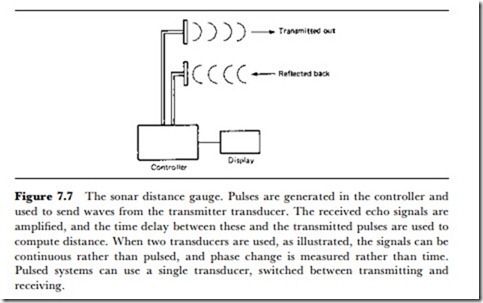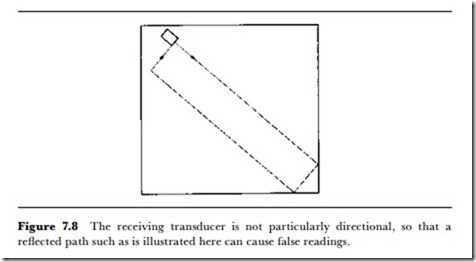Surveying and security
The application of electronic methods to security systems has considerably improved the chances of detecting and avoiding the hazards of intrusion, fire, smoke and theft. Earlier methods, such as the use of microswitches on doors and windows, and conductive films to detect broken windows, are still applicable, but this chapter deals mainly with the sensors and transducers in more recent electronic systems. For details of security systems, consult the books by Gerard Honey (Newnes).
CAPACITANCEDETECTORS
Capacitance detectors are proximity detectors that operate when an earthed object is taken close to the detector. The detecting surface is a conductor, so that this form of detection is particularly useful for metal objects like safes. Non-metallic objects can be protected using metal strips (preferably not visible from outside). A single cable can be used to link the detecting metal object back to the sensing electronics portion of the alarm, but unless this cable is shielded it will form part of the sensing system and may cause false alarms.
The associated electronics panel is typically an oscillator that uses the capacitance to earth of the sending panel as part of the tuning capacitor in an oscillator circuit. When the capacitance changes due to the presence of an intruder close to the sensing panel, the frequency of oscillation will also change and a phase-sensitive detector can be used to make this change of frequency cause a change of output voltage that will trigger a thyristor, so sounding an alarm.
PIEZOELECTRIC SENSORS
The piezoelectric effect has been noted in Chapter 5. Piezoelectric crystals are very efficient detectors of vibration, particularly at ultrasonic frequencies, so that these detectors are very useful in sensing breaking glass, for which a peak sensitivity at l50 kHz is usually specified. The sensor, a piezo-
electric crystal microphone, need not be in contact with the window or even close to the window, and several windows in a room can be monitored by one detector.
The same type of device can also be used in vibration detectors to sense when a door or other surface is being attacked. In this role, however, false triggering can be a problem because vibration can be caused by traffic or aircraft noise.
Piezoelectric devices are also used in ultrasonic detection systems. In such systems, one transducer is used to radiate ultrasonic energy, and another to detect it at a distance. The reflection of the radiated acoustic waves forms a standing-wave pattern, and any movement in this area will cause phase shifts and amplitude changes that can be detected by the receiving transducer. False triggering of ultrasonic systems can be caused by air currents or natural noises that contain an ultrasonic component.
The sonar distance gauge principle is illustrated in Figure 7.7. A beam of ultrasound, usually in the 40 kHz frequency range, is sent out from a transducer, usually as short pulses. At this frequency, the wavelength in air of the ultrasound is around 7.5 mm, so that the resolution of the system is of this order. The reflected beam is picked up, in this example by another transducer, and the time interval between sending and receiving is converted into a reading of distance, using either analogue or digital methods. The same transducer can be used both for transmitting and for receiving if the time interval between pulses is large enough to allow for the maximum delay of the beam in the largest space that will have to be measured.
The system requires some care if it is to be used correctly, because the
beam is invisible, making it impossible to be sure where the main reflecting point is located. False readings can be obtained if the beam is angled in a room, so that the distance that is measured includes more than one reflection (Figure 7.8).
For security systems, the ultrasonic beam is usually continuous, with a separate receiver transducer. Inside a room or other closed space, a complex pattern of standing waves is set up and the signal from the receiver transducer is compared with a phase-shifted signal from the transmitter, and the amount of phase shift and amplitude adjusted until the signals are of equal amplitude and phase. If these signals are then applied to a phase-sensitive comparator, then any change in the phase of the received signal will cause an output from the comparator that can be used to trigger an alarm. Such a phase change can be caused by an intruder, but the sensitivity of the system is often such that the alarm can be triggered by cats, mice or pieces of paper moving in a breeze. The more elaborate systems, therefore, use amplitude discrimination as well as phase shift to trigger the alarm.
TEMPERATURE SENSORS
Temperature sensors can be of either the bimetallic or thermistor (see Chapter 4) types. Bimetallic sensors are cheap and robust, and less liable to false triggering caused by brief exposure to heat. They can also be wired directly to the alarm device because their terminals are capable of handling larger amounts of current than the semiconductor type of sensor. In addition, the bimetal thermostat has a built-in hysteresis, meaning that once it has triggered it will stay in that state until the temperature is reduced to below the triggering temperature.
Thermistor sensors have the advantages that they can be much more sensitive, and can be microprocessor controlled so as to provide any desired hysteresis. This allows the response to short-term high temperature to be adjusted so as to eliminate most of the conditions that cause false triggering.
SMOKE SENSORS
Smoke sensors are either of the photoelectric or the ionization type, and because the characteristics are so different, both types should be used in critical situations. The photoelectric type uses a light source, usually an LED, along with a photocell, and responds to any obstruction of the light beam by smoke. This type of sensing is particularly suitable to detect smouldering (for example, from bed linen that has been in contact with a lighted cigarette) that is likely to lead to a fire, and is not affected by strong air currents.
The ionization type uses a weak radioactive source in a space (the ioniza- tion chamber) that contains metal surfaces (electrodes) with a voltage dif- ference. The radiating charged particles ionize the air in this space and so permit a small current to pass between the electrodes. This current is in the picoamp region, so that a DC amplifier is needed to sense it. Smoke particles, which may be so small as to be invisible, and fumes from a wide range of chemicals will cause the ionization current to drop, triggering the alarm. This type of detector is more suitable for detecting a fire that has broken out, before smoke has had time to trigger the photoelectric type. A snag is false triggering caused by humidity changes and vapours that are not a fire hazard. This can be overcome to some extent by suitable design of the ionization chamber.
INFRARED
Infrared sensors can be active or passive. The passive infrared sensors operate by detecting the thermal radiation from a body and the active systems use an infrared source to flood an area so that phase/amplitude changes can be sensed, or infrared cameras used to produce an image. The PIR systems generally use a pyroelectric sensor (see Chapter 4). Precautions are needed against false triggering produced by moving reflecting surfaces (such as pools of water, vibrating metal panels, etc.).
MICROWAVE
Microwave detectors operate by flooding an area, which can be a large area, with microwaves so that standing-wave patterns are established. A detector that is phase sensitive will respond to any disturbance in this pattern caused by any object moving within the range of the unit.
NIGHTFALL DETECTORS
Nightfall detectors use light sensors that switch the lighting system on when the incident light falls to a low level. These provide permanent floodlighting in the hours of darkness, and are useful when allied to CCTV. The position and sensitivity of the sensor has to be chosen so that it will not be affected by the lighting itself, nor by other stray light from surrounding houses, cars, the Moon, or other sources. This is not always easy, and a system that behaves perfectly in clear weather may cause problems in foggy conditions because of light scattering from the small water droplets in fog.
In addition, problems will arise if the sensor becomes obstructed. Because the sensor must not respond to the security floodlighting, it is often aimed at the sky, and is subject to obstruction by frost, rain or leaves. Unless regular cleaning is carried out, the glass cover of the sensor can become obscured by green slime or other algae.
TIMED SYSTEMS
Timed systems of lighting can be systematic or random. A timed system can be set, for example, to switch lights on at 10.00 p.m. and off again at 6.00 a.m., ensuring that the lights are on during hours when the premises are empty. This is another form of permanent lighting, and the regularity of the pattern is a disadvantage for any intruder who has observed the lighting for a few nights.
Random timed switching can be more effective. This switches the lighting on and off at random intervals during the hours of darkness, so presenting an element of surprise. Once again this is at its most effective when used along with CCTV.
SOUND ACTIVATION
Sound activated lighting systems are an effective method of deterring intrusion, making use of acoustic sensors operating some or all of a set of security lights. The sensing level can be chosen to avoid triggering from distant or faint sounds, although false triggering is not such a problem for security lights as it is for alarm systems. Miniature sound activating sensors can be incorporated in bulb-holders for domestic use, and can be combined with random-triggering circuits.
PIR SYSTEMS
PIR lighting is a very popular form of security system, particularly in low- cost form for domestic premises. The sensor may be part of the lighting unit, or a separate component, and is adjustable for aiming, sensitivity, and ambient light sensing. The larger units use one or more separate sensors, switching a number of lights.
STANDALONE SMOKE DETECTORS
See later in this chapter for details of smoke detector principles. Standalone smoke detectors are battery-operated and intended for domestic premises. They are predominantly of the ionization type, and should carry a warning about radiation hazards (the main factor being safe disposal of the radioisotope when the alarm is scrapped). The signalling unit is a piezoelectric tweeter that emits a volume of sound that is out of all proportion to its size and to the battery power. The battery is usually a 9 V alkaline type that provides a life of a year or more. End of battery life is signalled by a beep at a slow rate, typically one each 3 minutes. A test button is provided to check that the sounder is still operative. The whole device is packaged in a casing that is typically a shallow box about 13 cm square.
These alarms should be located in critical areas, particularly sleeping areas and in places where fire can originate such as kitchens or boiler rooms. In a kitchen, false triggering is likely from fan ovens and from grills, so that some care is needed over positioning.

